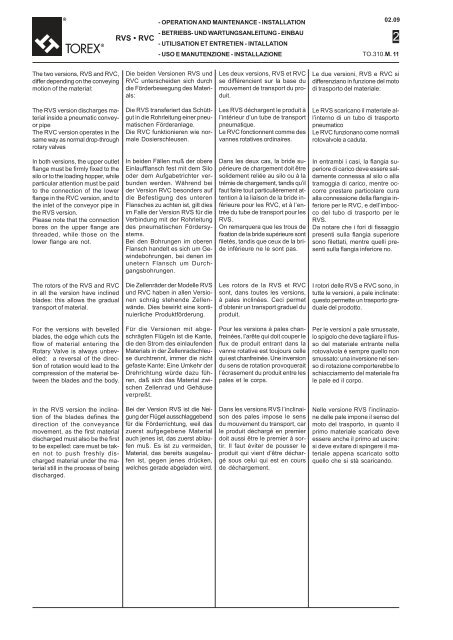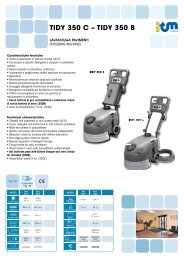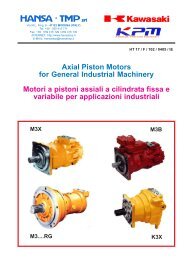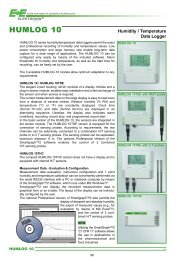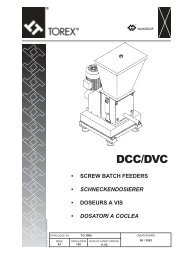Create successful ePaper yourself
Turn your PDF publications into a flip-book with our unique Google optimized e-Paper software.
<strong>RVS</strong> • <strong>RVC</strong>- OPERATION AND MAINTENANCE - INSTALLATION02.09- BETRIEBS- UND WARTUNGSANLEITUNG - EINBAU- UTILISATION ET ENTRETIEN - INTALLATION- USO E MANUTENZIONE - INSTALLAZIONE TO.310.M. 112The two versions, <strong>RVS</strong> and <strong>RVC</strong>,differ depending on the conveyingmotion of the material:Die beiden Versionen <strong>RVS</strong> und<strong>RVC</strong> unterscheiden sich durchdie Förderbewegung des Materials:Les deux versions, <strong>RVS</strong> et <strong>RVC</strong>se différencient sur la base dumouvement de transport du produit.Le due versioni, <strong>RVS</strong> e <strong>RVC</strong> sidifferenziano in funzione del motodi trasporto del materiale:The <strong>RVS</strong> version discharges materialinside a pneumatic conveyorpipeThe <strong>RVC</strong> version operates in thesame way as normal drop-throughrotary valvesDie <strong>RVS</strong> transferiert das Schüttgutin die Rohrleitung einer pneumatischenFörderanlage.Die <strong>RVC</strong> funktionieren wie normaleDosierschleusen.Les <strong>RVS</strong> déchargent le produit àl’intérieur d’un tube de transportpneumatique.Le <strong>RVC</strong> fonctionnent comme desvannes rotatives ordinaires.Le <strong>RVS</strong> scaricano il materiale all’internodi un tubo di trasportopneumaticoLe <strong>RVC</strong> funzionano come normalirotovalvole a caduta.In both versions, the upper outletflange must be firmly fixed to thesilo or to the loading hopper, whileparticular attention must be paidto the connection of the lowerflange in the <strong>RVC</strong> version, and tothe inlet of the conveyor pipe inthe <strong>RVS</strong> version.Please note that the connectionbores on the upper flange arethreaded, while those on thelower flange are not.In beiden Fällen muß der obereEinlaufflansch fest mit dem Silooder dem Aufgabetrichter verbundenwerden. Während beider Version <strong>RVC</strong> besonders aufdie Befestigung des unterenFlansches zu achten ist, gilt diesim Falle der Version <strong>RVS</strong> für dieVerbindung mit der Rohrleitungdes pneumatischen Fördersystems.Bei den Bohrungen im oberenFlansch handelt es sich um Gewindebohrungen,bei denen imunetern Flansch um Durchgangsbohrungen.Dans les deux cas, la bride supérieurede chargement doit êtresolidement reliée au silo ou à latrémie de chargement, tandis qu’ilfaut faire tout particulièrement attentionà la liaison de la bride inférieurepour les <strong>RVC</strong>, et à l’entréedu tube de transport pour les<strong>RVS</strong>.On remarquera que les trous defixation de la bride supérieure sontfiletés, tandis que ceux de la brideinférieure ne le sont pas.In entrambi i casi, la flangia superioredi carico deve essere saldamenteconnessa al silo o allatramoggia di carico, mentre occorreprestare particolare curaalla connessione della flangia inferioreper le <strong>RVC</strong>, e dell’imboccodel tubo di trasporto per le<strong>RVS</strong>.Da notare che i fori di fissaggiopresenti sulla flangia superioresono filettati, mentre quelli presentisulla flangia inferiore no.The rotors of the <strong>RVS</strong> and <strong>RVC</strong>in all the version have inclinedblades: this allows the gradualtransport of material.Die Zellenräder der Modelle <strong>RVS</strong>und <strong>RVC</strong> haben in allen Versionenschräg stehende Zellenwände.Dies bewirkt eine kontinuierlicheProduktförderung.Les rotors de la <strong>RVS</strong> et <strong>RVC</strong>sont, dans toutes les versions,à pales inclinées. Ceci permetd’obtenir un transport graduel duproduit.I rotori delle <strong>RVS</strong> e <strong>RVC</strong> sono, intutte le versioni, a pale inclinate:questo permette un trasporto gradualedel prodotto.For the versions with bevelledblades, the edge which cuts theflow of material entering theRotary Valve is always unbevelled:a reversal of the directionof rotation would lead to thecompression of the material betweenthe blades and the body.Für die Versionen mit abgeschrägtenFlügeln ist die Kante,die den Strom des einlaufendenMaterials in der Zellenradschleusedurchtrennt, immer die nichtgefaste Kante: Eine Umkehr derDrehrichtung würde dazu führen,daß sich das Material zwischenZellenrad und Gehäuseverpreßt.Pour les versions à pales chanfreinées,l’arête qui doit couper leflux de produit entrant dans lavanne rotative est toujours cellequi est chanfreinée. Une inversiondu sens de rotation provoqueraitl’écrasement du produit entre lespales et le corps.Per le versioni a pale smussate,lo spigolo che deve tagliare il flussodel materiale entrante nellarotovalvola è sempre quello nonsmussato: una inversione nel sensodi rotazione comporterebbe loschiacciamento del materiale frale pale ed il corpo.In the <strong>RVS</strong> version the inclinationof the blades defines thedirection of the conveyancemovement, as the first materialdischarged must also be the firstto be expelled: care must be takennot to push freshly dischargedmaterial under the materialstill in the process of beingdischarged.Bei der Version <strong>RVS</strong> ist die Neigungder Flügel ausschlaggebendfür die Förderrichtung, weil daszuerst aufgegebene Materialauch jenes ist, das zuerst ablaufenmuß. Es ist zu vermeiden,Material, das bereits ausgelaufenist, gegen jenes drücken,welches gerade abgeladen wird.Dans les versions <strong>RVS</strong> l’inclinaisondes pales impose le sensdu mouvement du transport, carle produit déchargé en premierdoit aussi être le premier à sortir.Il faut éviter de pousser leproduit qui vient d’être déchargésous celui qui est en coursde déchargement.Nelle versione <strong>RVS</strong> l’inclinazionedelle pale impone il senso delmoto del trasporto, in quanto ilprimo materiale scaricato deveessere anche il primo ad uscire:si deve evitare di spingere il materialeappena scaricato sottoquello che si stà scaricando.


